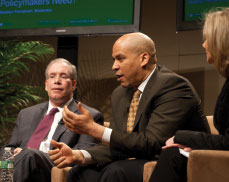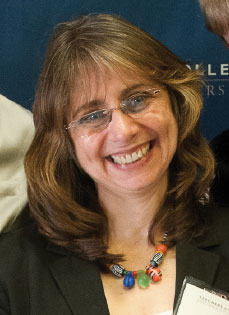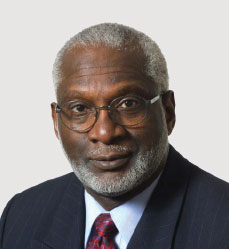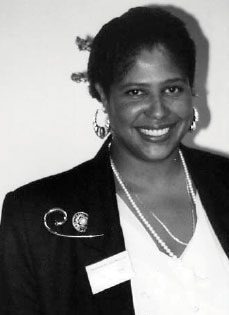Taking The Pulse Of The Community
Changing the health of populations, from neighborhoods to nations, starts with finding out what's really going on in people's lives and their communities.
By Joe Levine
When the aids epidemic emerged in the United States, why did it take such a toll among African Americans?
The short answer -- needle sharing among drug users and unsafe sex -- leads, at best, to narrowly focused solutions, and at worst, to what Barbara Wallace, Professor of Health Education, calls a "blame the victim" mentality.
A different answer, put forth this past spring at TC's Fifth Annual Health Disparities Conference, chaired by Wallace, touches on those same causes, but ends up in a very different place. It begins with the Federal Housing Act of 1949, which led to the bull-dozing of many black neighborhoods and destroyed aspects of communities that could have helped prevent, or at least minimize, the epidemic.
For example, between the early 1950s and 1990, the proportion of married adults in Harlem dropped from 85 percent to 16.7 percent, according to research conducted by Robert Fullilove (Ed.D. '84), Co-Director of the Community Research Group at Columbia's Mailman School of Public Health. What precipitated that drastic change? As neighborhoods vanished, Fullilove said, so did the adults sitting out on their stoops who knew and disciplined each other's children. Street gangs and drug-dealing proliferated, particularly as the economy stalled and jobs disappeared. The U.S. government declared its War on Drugs in 1971, and incarceration in the United States has since increased tenfold. Vast numbers of black men were removed from the community and concentrated in prison, where needle sharing and sex were prevalent.
"Drug use was a medical crisis, a public health tragedy, but we took something we might have been able to treat and we converted it into an issue managed by the police and the courts," said Fullilove, who is also Mailman's Associate Dean for Community and Minority Affairs and a TC adjunct faculty member. "HIV has a long latency period. And I'm one of those people who believes that between 1972 and 1981, when we formally recognized AIDS within our midst, a lot of transmission was happening in the prisons."
Fullilove's cautionary tale reflects an emerging paradigm in health education research and practice.
"The thinking is changing in two areas," says John Allegrante, Professor of Health Education and TC Deputy Provost. "One is to move beyond traditional measures of community health, which focus on monitoring changes in mortality and morbidity, to a broader focus on indicators of quality of life. The other is a shift from changing individual behaviors to looking at the social determinants and policy changes that can affect the health of communities."
As Allegrante describes in his 2004 textbook Derryberry's Educating for Health, those ideas have been part of the conversation since a pioneering health educator named Mayhew Derryberry (M.Ed. '33) first outlined them in the 1940s. Derryberry, the first Chief of Health Education for the U.S. Public Health Service, "foresaw that the most pressing health problems of the future would be chronic diseases such as heart disease and cancer, for which prevention through behavioral change would be the key," Allegrante says.
Now the public health world is catching up. Allegrante cites a recent report in which the Institute of Medicine of the U.S. National Academies describes a growing number of community-based prevention efforts that target "environmental and social conditions that are out of the reach of clinical services." That change, the report suggests, is the result of a new consensus that policy must address "the social determinants of health -- for example, socioeconomic status and educational attainment."
At Teachers College, two new centers are firmly in the vanguard of this new trend. One is the Center for Health Equity and Urban Science Education, co-directed by Barbara Wallace and Science Education faculty member Christopher Emdin, which hosted the health disparities conference in March. The other is the new Laurie M. Tisch Center for Food, Education & Policy, directed by Nutrition Education faculty member Pamela Koch, which was launched in February with a conference titled "Bringing Policy to the Table: New Food Strategies for a Healthier Society."
Both centers subscribe to the philosophy that "the way to move forward is to empower and engage communities, foster collaboration and provide the tools to implement change," as Tisch, a leading New York City philanthropist who serves as Vice Chair of TC's Board of Trustees, said at "Bringing Policy to the Table." Both also seek to bring heightened attention to more effective presentation of research evidence.
The Tisch Center, which Tisch funded through a $3.5 million gift to the College, is focusing on two increasingly prevalent problems in the United States: obesity (and related issues such as diabetes) and "food insecurity," or, in layman's terms, hunger.
At the nutrition conference in February, where several high-ranking local and national leaders shared lessons learned from health interventions they have launched with com-munities, Manhattan Borough President Scott Stringer remembered calling a meeting in East Harlem to unveil a grand plan centered on food. When only eight people showed up, Stringer realized he needed to take a less top-down approach.
"It was a very awakening moment for me," he said. "We went back and asked people what they wanted for a sustainable, healthy community. You know what we learned? People didn't really trust the big hospitals. They wanted a place where they could test their kids for asthma and learn about mold. So we worked with Mayor Bloomberg and the City Council to build a stand-alone asthma center. They said, -'We have no trees,' so we worked with [singer and philanthropist] Bette Midler and the Parks Department to bring everyone together and start planting some trees around here. And finally, we said in terms of healthy food we've got to get the store owners and restaurateurs, who already have these wonderful community dishes in all these different cultures and backgrounds."
The latter effort resulted in the publication of The Go Green East Harlem Cookbook, printed in English and Spanish, which Stringer edited and which his office has since distributed widely across the city and beyond.
"The point is, to lift up people health-wise we need to get out into every community and make the case," Stringer said.
Speaking at the health disparities conference in March, Charles Basch, TC's Richard March Hoe Professor of Health Education, pointed to schools as community sites where health practitioners can bring about the most significant change. Declaring that "schools are the safety net that makes the most sense," Basch reiterated his call for a comprehensive, strategic school-based health plan that would bring together all the key players in students' lives to address health issues like asthma, teen pregnancy and violence, which disproportionately affect minority students. To illustrate that concept, he urged adoption of the asthma prevention program created by the U.S. Centers for Disease Control and Prevention, which includes case management for students with asthma and follow-up by school nurses on deployment of inhalers.
Of course social determinants of community health are well understood by those who experienced them firsthand.
In his keynote address, David Satcher, who served as U.S. Surgeon General during the Clinton administration, confided that as a toddler in one of the poorest areas of rural Alabama, he would have died of pneumonia had not the area's only black doctor come out to the family's farm. By age six, Satcher said, he had decided that, against all odds, "I would become a doctor like him and make a difference for people like us who lacked access to health care.
"So many things come together to decide whether a child will survive that first year of life," continued Satcher, who founded and now directs the Satcher Health Leadership Institute at Morehouse School of Medicine. "Prenatal care, nutrition, whether or not parents are abusing drugs, levels of folic acid in food. So access to health care determines how healthy you're going to be, and changing behavior even more so -- but ultimately the social determinants override even those things. And that's why transforming communities is so important."
Published Thursday, Jun. 27, 2013



